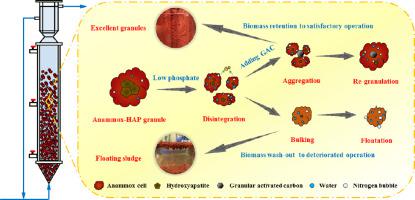Science of the Total Environment ( IF 8.2 ) Pub Date : 2021-09-16 , DOI: 10.1016/j.scitotenv.2021.150359 Lei Liang 1 , Jinghuan Luo 1 , Xiangmin Xiao 2 , Jianwei Wang 2 , Meng Hong 2 , Chao Deng 2 , Yu-You Li 3 , Jianyong Liu 1

|
Anaerobic ammonium oxidation (anammox) coupled with hydroxyapatite (HAP) crystallization not only achieves simultaneous nitrogen removal and phosphorus recovery, but also cultivates excellent anammox granules. However, a floatation and wash-out of anammox-HAP granules was occurred at low phosphate concentrations. In this study, a reactor inoculated with mature anammox-HAP granules and fed with low phosphate (5 mg P/L) was added with granular activated carbon (GAC) to maintain sludge granulation and nitrogen-removing stability. At influent total nitrogen >800 mg/L and nitrogen loading rate ~ 9.8 kg/m3/d, a satisfactory nitrogen removal of around 88% was maintained during 140 days of operation. Insufficient phosphate supplement resulted in a sludge bulking, with suspended solid and sludge density decreased whereas sludge water content and expansion ratio increased due to HAP loss. Nevertheless, the sludge re-granulation was found at the later stage as the proportion of granules in 2.8– 3.35 mm went up to 37.4% after large granules disintegrated into small pieces at the initial stage. The settling velocity was finally ranging from 129.8 to 182.2 m/h. In addition, Candidatus Brocadia was increased from 2.1% to 20.1% and dominated in the microbial community. These findings suggest GAC was able to promote re-granulation of anammox-HAP granules at low phosphate concentration, which avoids sludge flotation and widens their application as an inoculum.
中文翻译:

颗粒活性炭促进厌氧氨氧化-羟基磷灰石颗粒的再造粒,在低磷酸盐浓度下稳定脱氮
厌氧氨氧化(anammox)结合羟基磷灰石(HAP)结晶不仅实现了脱氮磷回收的同步,而且培养出优良的厌氧氨颗粒。然而,在低磷酸盐浓度下发生了厌氧氨氧化-HAP 颗粒的漂浮和冲洗。在这项研究中,一个反应器接种了成熟的厌氧氨氧化 HAP 颗粒并加入低磷酸盐 (5 mg P/L),加入颗粒活性炭 (GAC),以保持污泥颗粒化和脱氮稳定性。在进水总氮 >800 mg/L 和氮负载率 ~ 9.8 kg/m 3 时/d,在 140 天的运行期间,令人满意的脱氮率保持在 88% 左右。磷酸盐补充不足导致污泥膨胀,悬浮物和污泥密度降低,而由于HAP损失,污泥含水量和膨胀率增加。然而,在后期发现污泥重新造粒,2.8-3.35 mm 的颗粒比例在初始阶段大颗粒分解成小块后上升到 37.4%。沉降速度最终在 129.8 至 182.2 m/h 的范围内。此外,候选人Brocadia 从 2.1% 增加到 20.1%,并在微生物群落中占主导地位。这些发现表明 GAC 能够在低磷酸盐浓度下促进 anammox-HAP 颗粒的再造粒,从而避免污泥浮选并扩大其作为接种物的应用。











































 京公网安备 11010802027423号
京公网安备 11010802027423号